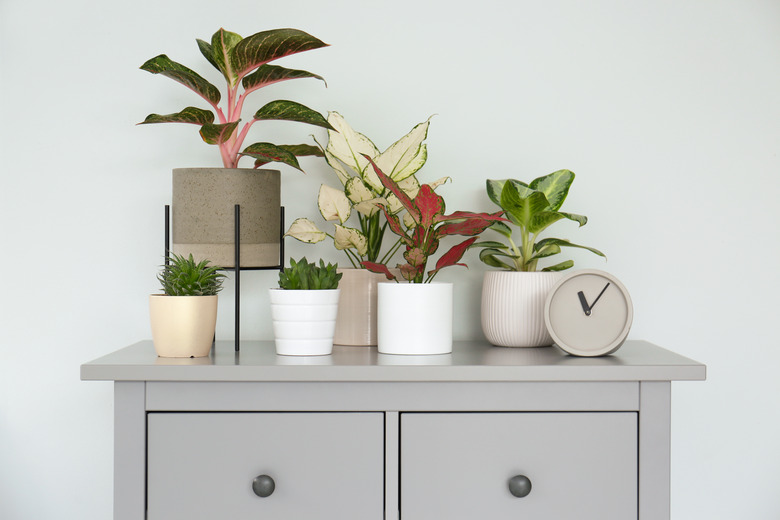Root Rot Cure
We may receive a commission on purchases made from links.
Root rot can and will quickly kill your houseplant if it is not treated immediately upon its discovery. While you might apply a homemade fungicide for root rot to the soil, it is more effective to remove the plant from the soil, prune the affected roots, and replant in fresh potting mix. To help prevent root rot, monitor soil moisture and your plants carefully, as overwatering can be fatal.
Preventing Root Rot
Preventing Root Rot
The primary cause of root rot in houseplants is overwatering and poor drainage. Allow the potting mix to dry to the touch or to a depth of 1 to 2 inches depending on the plant and its moisture needs. Add water until it drains from the bottom of the flowerpot. Never allow water to sit in the saucer under the pot, as it will wick back up into the potting mix and keep the soil too wet for the plant's roots.
In addition, the wet conditions stress the plant and encourage fungal growth in the soil. If you make your own potting mixes using garden soil or compost, you may also import naturally occurring fungi into your indoor garden. Fungi species like Berkeleyomyces, Fusarium, Rhizoctonia, and Pythium can live for years in the soil. Sterilize garden soil and compost before combining it with peat moss, coconut coir, sand, perlite, and other organic ingredients when making a homemade potting mix.
Identifying Root Rot
Identifying Root Rot
Root rot is hard to identify since the damage to the plant is done under the surface of the soil. By the time you notice that your plant is wilting with yellowing leaves, growing poorly, and/or beginning to die back, the roots may be completely infected and rotting. All too often, your first thought when a plant wilts is that it needs water. If the potting mix is already moist, root rot may be the cause of the wilting.
To identify root rot, put on gloves, a dust mask, and safety goggles and spread newspapers or a plastic tablecloth over the counter. Place the flowerpot on its side and slide the plant out of the pot. If the roots are black, brown, mushy, and/or slimy, you must take action to save your plant.
Saving Your Plant
Saving Your Plant
If the entire root system is brown and mushy, your best bet is to take cuttings from any healthy-looking stems and root them in fresh water or sterile potting mix. However, if some of the roots are still firm and white, you may still be able to save the plant.
Carefully rinse the soil from the roots using a colander lined with cheesecloth to prevent the mix from going down the drain. Discard the old potting soil in the trash. Examine the roots carefully. Then, using scissors or pruners sterilized by wiping the blades with rubbing alcohol or dipping them into Lysol, cut off all the damaged and diseased roots.
Prepare fresh potting mix in a new or recycled and disinfected flowerpot. The mix should be damp but not waterlogged. Replant the plant at the same depth as it was in the original pot. Sterilize your pruners again and trim back the foliage as needed. Save the cuttings to start new plants.
Applying Homemade Fungicide for Root Rot
Applying Homemade Fungicide for Root Rot
While too much water encourages fungal growth, after repotting, the remaining roots need water and oxygen. Mix 1 part 3 percent hydrogen peroxide with 2 parts room-temperature water and pour it over the potting mix to rehydrate the roots and kill any remaining fungi. Allow the solution to drain from the pot and then refrain from watering again until the top of the soil is dry to the touch.
You can use hydrogen peroxide as a preventive treatment for root rot. Mix one part hydrogen peroxide with two parts water and water the plant weekly or biweekly with the solution. This helps if you tend to overwater, as the extra oxygen molecule in hydrogen peroxide provides additional oxygen to the plant's roots as it kills fungi. When applied in a 1-to-3 solution, it kills fungus gnats and their larvae.
While you might use a commercially prepared fungicide solution for root rot to kill fungi in the soil, most are only effective against a few of the various fungi species. It is important to know which fungi are infecting your indoor garden before treating your plants with a chemical or copper fungicide for root rot. Otherwise, the treatment will be a waste of your time and money.
References
- University of Florida IFAS Gardening Solutions: Disinfecting Your Garden Tools
- Pennington: Recovering From Root Rot
- Texas A&M AgriLife Extension: Texas Plant Disease Handbook – Stem and Root Rot
- Greenhouse Management: Black Root Rot: Everything You Need to Know
- Plant Care Today: How To Use Hydrogen Peroxide for Root Rot?
- North Carolina State Extension: Black Root Rot on Ornamental Plants
